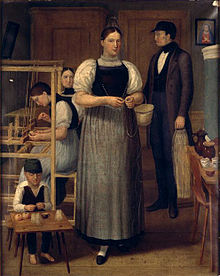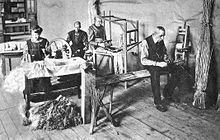Straw weaving
The straw weaving is a craft in which from straw and other natural raw items such as hats , caps, bags, shoes , lace manufactured or Hutschmuck. The straw comes from summer wheat or summer rye . It is split, braided, bleached and finally flattened.
While the handicraft was initially still largely carried out by the rural population as a homeworker , in the first half of the 19th century a flourishing branch of industry developed from it in some agricultural regions of Europe, which mainly concentrated on the production of straw hats and partly up to the 1970s persisted.
The centers of straw processing were Bedford , Hertford and Luton in England , Tuscany , Veneto and Lombardy in Italy, and Lower Saxony , the Black Forest , Silesia and Allgäu in Germany . However, the straw industry was of greatest importance in Switzerland and in particular in the Wohlen region in the southeast of the canton of Aargau .
processing

The farmers cut the stalks shortly before they were ripe with a sickle or scythe and, when the weather was good, laid them out in the field to dry (when the weather was bad, they hung the tufts of stalks in the barn). Leaves and leaf sheaths were removed from the dried stalks and bleached with sulfur . Then the tips of the stalks were cut to the first knot and the stalks were sorted according to their thickness. This was done with a straw sieve, a rectangular wooden box with exchangeable sieve bases. The farmers sold the prepared and pre-sorted straws to a fergger ( middleman ) who moved from farm to farm.
In the first quarter of the 19th century, the following processing operations were still being carried out at home in many places, until (semi-) machine processing took hold in factories. The straws were slit lengthwise with a straw ripper and flattened, then the inside of the pith was cleaned with the straw scraper. The moistened or greased stalks were then pulled back and forth in a stalk grater (two hardwood rollers clamped in a solid frame with a crank and press beam) in order to make them smooth and supple.
With a straw ripper, narrow strips of straw could also be torn and processed into fine strings in a twisting process. These served as the starting material for decorations. Split and rolled strips of straw were also glued to Japanese paper and cotton fabric , and various animal and plant motifs could be punched or pressed from the straw sheets produced in this way. It was also possible to make net-like braids from strings of straw, which were embroidered with motifs and ornaments.
The introduction of modified Jacquard - looms for further processing of straws led in 1830 to replace the existing publishing system . The factory system finally caught on around ten years later with the use of braiding machines . Together with cotton, hemp , horsehair , raffia , silk and ramie , there were countless possibilities for design, especially in hat production. At the beginning of the 20th century, semi-synthetic materials such as B. cellophane , Manila hemp or viscose added.
Museums
The Museum of Straw Processing in Twistringen , the Straw Museum in the Park in Wohlen (Switzerland) and the Hat Museum in Lindenberg (Bavaria) give an impression of the former economic importance and the diverse uses of straw .
See also
literature
- Dieter Kuhn, Anton Wohler, Marcela Hohl, Birgit Littmann: Straw times - history and stories of the Aargau straw industry . AT Verlag, Aarau 1991, ISBN 3-85502-428-6 .
